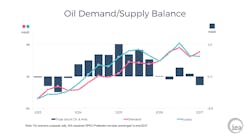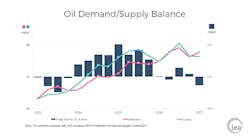Assuming stable oil production from the Organization of Petroleum Exporting Countries, oil demand should outpace oil supply in this year’s second half, but excess inventories will persist into 2018, according to forecasts made by the International Energy Agency in its latest monthly Oil Market Report.
This month’s report includes a first look at detailed 2018 demand numbers, which show global oil demand growth accelerating modestly supported by economic growth and the one-off impact of India’s recovery from the setback caused by its currency reform. Expanding by about 1.4 million b/d in 2018, global demand will average 99.3 million b/d—a new record.
In the report, however, IEA expects that even stronger output from the US and other non-OPEC producers in 2018 will outpace the demand increase. Growth in total non-OPEC production in 2018 is forecast to be 1.5 million b/d compared with expected growth of 660,000 b/d this year.
In 2017, IEA expects US crude supply to rise 430,000 b/d and the year will end with production 920,000 b/d higher than at yearend 2016. The agency’s first look at 2018 suggested that US crude production will increase 780,000 b/d year-over-year, but “such is the dynamism of this extraordinary, very diverse industry it is possible that growth will be faster.”
Further gains from Brazil and Canada also are expected in 2018. The UK, Kazakhstan, Ghana, and Congo (Brazzaville) also will see higher production next year, while continued declines are expected from Mexico and China.
Market updates
The global demand forecast continues to show growth of 1.3 million b/d in 2017 despite significant downgrades to estimates of the first half’s demand. IEA maintains the view that most of the factors that slowed growth in this year’s first half are likely to prove transitory.
First, the negative impact of India’s currency reform has already shown signs of passing and substantially stronger Indian demand growth is forecast over the remainder of the year. Second, due to similar one-off factors that restrained Chinese demand growth in the second half of 2016, such as forced factory closures and flooding, growth is expected to accelerate in this year’s second half.
Third, the recent fall in crude oil values will ease upward pressure on retail prices and thus provide downward pressure on demand growth.
Global oil supply rose 585,000 b/d in May to 96.69 million b/d as both OPEC and non-OPEC countries produced more. Output stood 1.25 million b/d above a year ago, the highest annual increase since February 2016. Gains were dominated by non-OPEC producers, particularly the US.
OPEC crude oil output rose 290,000 b/d in May to 32.08 million b/d—the highest level so far this year—after comebacks in Libya and Nigeria, which are exempt from supply cuts. Output from members bound by the production deal edged lower, which kept year-to-date compliance strong at 96%. Compared with May 2016, OPEC crude production was down 65,000 b/d.
Commercial stocks from members of the Organization for Economic Cooperation and Development rose in April by 18.6 million bbl on higher refinery output and imports. Stocks stand 292 million bbl above the 5-year average and are higher than when OPEC decided to cut output.
For May, preliminary data suggests stocks falling in Fujairah, Japan, Europe, Singapore, and in vessels offshore, but rising in the US and China.

